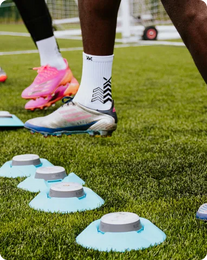The Pro Agility 5-10-5 Test, aka The 5-10-5 Shuttle, the Pro Agility Test or Short-shuttle Test, is a classic drill used to estimate a player’s overall agility or speed. A part of high school and NFL combine tests, this assessment is conducted in other sports that demand excellent change of direction, mobility, power, and speed control.
Besides using it for player assessment, a coach may also use pro agility shuttle drills in a practice format to develop his players’ explosiveness, speed, and leg strength.
This post will cover what the 5-10-5 shuttle test is all about and how to ace it.
The 5-10-5 Pro Agility Test Explained
The pro shuttle test is a popular combine drill commonly used to measure a player’s lateral agility. This test assesses an athlete’s ability to change direction (from left to right and vice versa) without losing balance.
As a speed-based assessment, this test also showcases the individual’s overall performance in terms of explosiveness, acceleration, deceleration, body control, and sheer power. Technically, all of these are the main attributes necessary in most competitive team sports. So while this test is commonly conducted in the NFL combine, it’s also used by coaches and scouts in the NBA and other field and court sports, including soccer, lacrosse, rugby, softball, volleyball, and baseball.
Benefits of the 5-10-5 Agility Test
As a coach, the pro agility shuttle test offers an excellent method of hunting for athletes that match your talent needs in the scouting zone. If your players have been emphasizing exercises that improve agility, this test also presents an incredible way of assessing their improvement over time.
The primary benefit of the 5-10-5 shuttle test is its simplicity. It is a simple assessment that you can conduct with minimal preparation.
Blazepod will come in handy regarding accuracy compared to the traditional way of using a stopwatch. This test also requires around three cones.
The only issue with this agility assessment method is that you can’t evaluate multiple athletes in one go. But this is a non-issue when using Blazepod.
How to Do The 5-10-5 Pro Agility Test
What You’ll Need
Requirements:
- Track or field - with a possibility to mark the 20-meter course layout. The track should be non-slip and flat to ensure that the results are as accurate as possible.
- Measuring-tape and three cones - to mark the course layout.
- Blazepod or a stopwatch - to record the athletes’ speed.
- A notepad - to record each participant’s performance and any other important information, such as gender, height, and weight. Besides comparison, this information also helps in evaluating improvement over time.
Pro Agility Test Procedure
- Start by measuring and marking the running course by placing three cones in a straight line 5 meters apart.
- If you’re using a Blazepod, align it with the centerline. Otherwise, the coach or inspecting personnel should stand near the middle cone with the stopwatch to guide and time the player.
- To start the test, the participant needs to get into position on the centerline facing the Blazepod. The participant should stand with his feet shoulder-width apart and with one hand touching the line. The hand touching the ground marks the direction that they will run in.
- On the whistle or coach’s cue, the player explodes out of their stance and moves sideways to crossover towards the left cone or line. Nearing the left-hand side cone, the player touches the line with the left foot and hand and then turns to sprint 10 yards through the center cone towards the opposite end line.
- He loads his weight to his right as he approaches the last cone to touch the line with the right foot and hand. Almost instantly, the athlete explodes again to cross the centerline. That marks the end of their first trial.
- Let the participant relax for about 5 minutes before taking another trial.
Ideally, each player should take 2-3 trials. The time is rounded to the nearest second. The player’s overall performance will be the best record of the trials. If you’re using a stopwatch, you should be keen and sharp to start it as soon as the action begins.
How Long is a Pro Agility Test?
As mentioned, the 5-10-5 shuffle is a pretty fast and straightforward test. Excluding the time spent to set up the running course, most players require well under 10 seconds for the 20-yard sprint. Perhaps the most crucial question here is, “what is a good 5-10-5 pro agility test time?”
Any time below 4 seconds is considered excellent.
Such a score would automatically rank you among the best athletes in most pro agility test norms. But generally, participants who record a pro agility test time of 4.5 seconds and below are considered overall good athletes from agility, speed, and lateral quickness perspectives.
The fastest 5-10-5 agility time in history was recorded at 3.73 seconds by Wide Receiver Kevin Kasper from Iowa in 2001. The most recent pro agility test record was 3.97 seconds in 2020 by Penn State Nittany Lions DB, Reid, John.
But note that the NFL does not keep official combine results. So these records are unverified and not official.
How to Beat the 5-10-5 Shuttle Run
Start with a great stance
The stance is among the main areas where time is lost in a pro agility drill. To start:
- Squat into a comfortable and confidence-inspiring athletic base.
- Load your weight slightly into the balls of your feet and the hand on the ground.
- Importantly, ensure that you’re not leaning towards the ground because when you start running, you’ll stagger forward first instead of sprinting laterally.
Perfect how to transition out of the line
The other area where athletes lose most of their speed is when getting in and out of cuts. The major problem with most players is that they don’t set up their bodies to change direction once they start accelerating from one line. So as they approach the opposite line, they take quick choppy steps to avoid overshooting.
Ultimately, making efficient turns during this drill comes down to understanding your steps and being aware of where you are as you get closer to the line. This awareness will make it easy to control the body angle allowing you to explode out of each line with minimal speed loss.
Another crucial aspect here is to lower your center of gravity during the turns. This helps a lot in maintaining balance to avoid loss of control.
Get as much distance from your first step
Another common mistake that athletes make when running a 5-10-5 shuttle is standing up before accelerating to their top speed. You want to explode laterally from the word go. Remember that any fraction of a second spent correctly will help you cover more ground with each step.
Explode through the finish
As you run the last 5 meters, you’re not thinking of making another quick turn. So kick in that last gear and bomb through the finish line as you would in a 40-meter sprint.
Perfect your steps, then work on speed
If you are scheduled for a pro agility test, it only makes sense to try it a couple of times before the actual test. This is vital for several reasons, but the most important is knowing how many steps you need for each cut. The amount mainly depends on your strides and overall quickness.
Once you understand how many steps it takes you to get to the opposite line, it becomes easy to control your body angle, thereby making the most out of your shuttle run technique.
How to Improve Speed and Agility
If you have clients looking for tips on passing the police agility test or high school or NFL combines, they are most likely looking to get faster.
To help them improve their speed, you want to focus on agility exercises that develop explosive power, balance, and leg strength.
Here are some of the best exercises to improve agility:
- Lateral plyometric jumps
Lateral plyometric jumps are full-body workouts that activate your hamstrings, glutes, quadriceps, and calves. With proper form, these exercises help develop explosive power and stability when moving from side to side.
- Lateral running drills
Lateral speed training is essential to your athletes’ workout regimen as it challenges their ability to explode, accelerate, decelerate, stabilize, and stop.
Bodyweight lateral speed slides are one of the best drills to develop lateral speed. Position 2 cones 10 yards apart. From one cone, perform a speedy lateral slide towards the second cone, trying not to overshoot. At the opposite cone, turn and sprint to the starting position. Rest for a few minutes, then repeat for desired reps.
- Hill sprints
Powering up hills develops leg-muscle strength, which is essential for quicker and longer strides. Training on hills also builds your athletes’ arm and shoulder action- a critical component for acceleration in a 5-10-5 shuttle. Your athletes should aim for around ten hill sprints of 10 seconds each, twice a week.
- Interval runs
Interval running involves alternating between short bursts and light jogging or walking. Depending on your clients’ athleticism, they could run hard for 50, 100, 150, or 200m and jog or walk for 50m to allow time for recovery.
- Box jump drills
Box jumps are another form of plyometrics that target your core, glutes, hamstrings, and quads to further boost your athletes’ power and explosiveness. The beauty of the drill is the ability to adjust the height of the boxes depending on the goal. For instance, while higher box jumps improve explosiveness, lower box jumps target foot speed and cardio endurance.




















